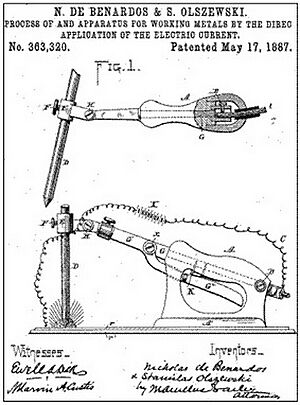Carbon arc welding facts for kids
Carbon arc welding (CAW) is a type of arc welding. It joins pieces of metal by heating them with a very hot electric spark. This spark is created between a special carbon rod, called an electrode, and the metal you want to weld.
CAW was the very first arc welding method ever invented. Today, it's not used as much because newer, more advanced welding methods have taken its place. The main idea of arc welding is to make separate metal parts stick together strongly. In carbon arc welding, the carbon electrode creates an electric spark. This spark gets incredibly hot, over 3,000 degrees Celsius (5,400 degrees Fahrenheit)! At this extreme heat, the metal pieces melt and join together, becoming one strong piece.
How it was Developed

Carbon arc welding could not have been made without an important discovery. This was the discovery of the electric arc. Humphry Davy first found the electric arc in 1800. A Russian scientist named Vasily Vladimirovich Petrov also found it on his own in 1802. Petrov studied the electric arc and thought about how it could be used. He even suggested it could be used for welding.
The people who invented carbon arc welding were Nikolay Benardos and Stanisław Olszewski. They created this method in 1881. Later, they received a patent for it. They called their invention Elektrogefest, which means "Electric Hephaestus." Hephaestus was the Greek god of blacksmiths and fire.
Different Types
- Twin carbon arc welding (TCAW) is a type where the electric spark is made between two carbon electrodes instead of just one.
- Other modern welding methods have replaced carbon arc welding. These include tungsten-arc welding (also called GTAW or TIG) and plasma-arc welding (PAW). These methods also use an electrode that doesn't melt. Usually, extra metal, called filler metal, is added to help the pieces join even better.

